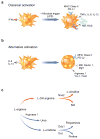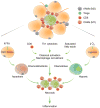Alternative macrophage activation and metabolism
- PMID: 21034223
- PMCID: PMC3381938
- DOI: 10.1146/annurev-pathol-011110-130138
Alternative macrophage activation and metabolism
Abstract
Obesity and its attendant metabolic disorders represent the great public health challenge of our time. Recent evidence suggests that onset of inflammation in metabolic tissues pathogenically links obesity to insulin resistance and type 2 diabetes. In this review, we briefly summarize the extant literature, paying special attention to the central role of the tissue-associated macrophage in the initiation of metabolic inflammation. We argue that rather than representing simple inflammatory disease, obesity and metabolic syndrome represent derangements in macrophage activation with concomitant loss of metabolic coordination. As such, the sequelae of obesity are as much products of the loss of positive macrophage influences as they are of the presence of deleterious inflammation. The therapeutic implications of this conclusion are profound because they suggest that pharmacologic targeting of macrophage activation, rather than simply inflammation, might be efficacious in treating this global epidemic.
Conflict of interest statement
The authors declare that they have no competing financial interests, memberships or funding that affected the objectivity of this review.
Figures






References
-
- Flegal KM, Carroll MD, Ogden CL, Curtin LR. Prevalence and trends in obesity among US adults, 1999–2008. JAMA. 2010;303:235–41. - PubMed
-
- Mokdad AH, Marks JS, Stroup DF, Gerberding JL. Actual causes of death in the United States, 2000. JAMA. 2004;291:1238–45. - PubMed
-
- Mokdad AH, Marks JS, Stroup DF, Gerberding JL. Correction: actual causes of death in the United States, 2000. JAMA. 2005;293:293–4. - PubMed
-
- Olshansky SJ, Passaro DJ, Hershow RC, Layden J, Carnes BA, et al. A potential decline in life expectancy in the United States in the 21st century. N Engl J Med. 2005;352:1138–45. - PubMed
-
- Reaven GM. Multiple CHD risk factors in type 2 diabetes: beyond hyperglycaemia. Diabetes Obes Metab. 2002;4(Suppl 1):S13–8. - PubMed
Publication types
MeSH terms
Grants and funding
LinkOut - more resources
Full Text Sources
Other Literature Sources
Medical
Research Materials

